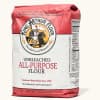Bleached versus Unbleached Flour
What is the difference between bleached and unbleached flour, and should you buy one over the other?
When flour is first milled, it has a yellowish cast that some consumers find unappealing. Within a few months of milling, however, these carotenoids, or pigments, in all-purpose flour naturally whiten. Because it is expensive to naturally “age” flour, some producers expedite the process chemically. In flours labeled “bleached,” benzoyl peroxide has likely been used to fade the yellow color. In baking tests, bleached flour was criticized for tasting flat or having “off” flavors (texturally, the flours behaved the same). These characteristics, however, were much harder to detect in recipes with a high proportion of ingredients other than flour, such as cornbread or oatmeal cookies.
To find out if bleached flour would compromise the flavor or texture of a savory sauce, we made batches of basic white sauce (béchamel) using 1 tablespoon of bleached or unbleached flour per cup of milk. We tasted the sauces plain as well as in lasagna Bolognese. In both instances, tasters pronounced the sauces identical in flavor and texture. Our conclusion: It’s fine to use small amounts of bleached flour to thicken sauces, but avoid using it for baking.


